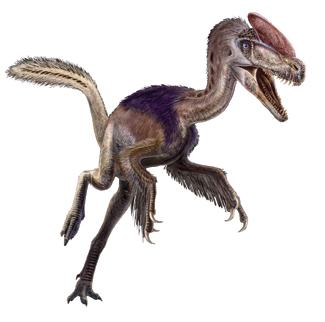Geotimes

Untitled Document

News Notes
Paleontology
Tiny T. rex cousin
A new fossil find from China has filled another branch on the tyrannosaurid
family tree. The fossil is about 95 million years older than Tyrannosaurus
rex, but is clearly a relative of the thunderous carnivore from the Cretaceous.
The find gives paleontologists a better idea of when and how the branch of meat-eating
dinosaurs that would eventually lead to T. rex evolved.
 In
northwestern China, researchers recently found a new species of tyrannosaurid,
called Guanlong wucaii, that is much older and much smaller than its
better-known cousin, the Tyrannosaurus rex. Image by Zhang Zongda/IVPP;
courtesy of Greg Erickson.
In
northwestern China, researchers recently found a new species of tyrannosaurid,
called Guanlong wucaii, that is much older and much smaller than its
better-known cousin, the Tyrannosaurus rex. Image by Zhang Zongda/IVPP;
courtesy of Greg Erickson.
Most tyrannosaurid fossils have been found in Cretaceous sediments, and before
this find, which dates to 160 million years ago, the oldest fossil discovered
was 130 million years old. Given where T. rex is on the evolutionary
tree, paleontologists have long suspected that T. rex and other tyrannosaurids
from the Cretaceous had much older ancestors that would have lived during the
Jurassic, says Peter Makovicky, assistant curator of paleontology at the Field
Museum in Chicago, Ill. But, he says, the record has been spotty to date. “This
is an important find. It’s nice to have that [expectation] confirmed.”
That confirmation came from two nearly complete specimens of the new tyrannosaurid,
called Guanlong wucaii — meaning “crowned dragon of the five colors,”
referring to the colorful rocks of the fossil-rich Xinjiang province in northwestern
China in which the specimens were found. As described in the Feb. 9 Nature,
G. wucaii would have been about 3 meters (10 feet) long from nose to
tail and stood about 1.1 meters tall at the hip — about one-quarter of the size
of T. rex.
Like its larger cousin, G. wucaii was bipedal, with “serrated, meat-eating
teeth” and “big, recurved claws,” says Greg Erickson, a paleontologist at Florida
State University in Tallahassee, who was part of the research team. G. wucaii
and T. rex also had similar “nasal features and hips.” However, the new
species’ arms were longer and thinner than T. rex’s and it was more agile,
similar to many Jurassic-aged predators, Erickson says.
G. wucaii also had a “most unusual feature, a crest, that was very delicate,
probably very colorful,” Erickson says. The cranial crest, which was fully preserved
in both fossil specimens, was about 1.5 millimeters thick. “There’s no doubt
it was for sexual display or species recognition,” he says. Crests such as this
have been found in other meat-eating dinosaurs at the time, but not in the tyrannosaurid
line and in very few dinosaurs after the Jurassic, Makovicky adds. “Crests may
have been an evolutionary fad,” he says.
Comparing the bones and the “mosaic evolution” of features in T. rex
to its older cousin helps researchers to understand growth patterns and thus
the dinosaurs’ lives, Erickson says. For example, based on the specimens, researchers
determined that G. wucaii grew more slowly than T. rex but reached
adulthood and died earlier, with a lifespan less than half that of T. rex.
Thus, over time, he says, tyrannosaurids grew larger and more quickly.
“If you want to learn how any creature, including man, came to be the way
it is, you have to learn about their lineages,” Erickson says. “This find helps
us figure out how T. rex grew to be giants.”
Megan Sever
Back to top
Untitled Document

 In
northwestern China, researchers recently found a new species of tyrannosaurid,
called Guanlong wucaii, that is much older and much smaller than its
better-known cousin, the Tyrannosaurus rex. Image by Zhang Zongda/IVPP;
courtesy of Greg Erickson.
In
northwestern China, researchers recently found a new species of tyrannosaurid,
called Guanlong wucaii, that is much older and much smaller than its
better-known cousin, the Tyrannosaurus rex. Image by Zhang Zongda/IVPP;
courtesy of Greg Erickson. 
